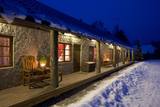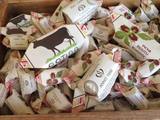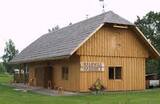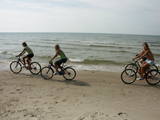| Нo | Название | Описание |
|---|---|---|
|
На фольклорной тропе объясняется письменность предков, символы и содержание дайн. Здесь можно узнать о значении растений для здоровья, попеть песни и поиграть. Предлагаются ритуалы на все случаи жизни (крестины, обряд «расплетания невесты» - «перевод» молодой пары в новый ранг и др.), огненные и банные ритуалы, праздник всех праздников года. По предварительной договоренности можно отведать традиционные блюда. |
||
|
Предприятие уже 16 лет выпускает классических, медовых, ментоловых с имбирем и облепиховых сахарных петушков и другие кондитерские изделия, а также готовит сок из гриба весёлки, который издавна известен как народное лечебное средство. Покупка продукции. |
||
|
Atrodas 4,5 km ziemeļos no Rīgas – Daugavpils šosejas (A 6), klajā laukā (ap 3 m augsts, ainavisks). Viens no izcilākajiem Latvijas muldakmeņiem, tādēļ ir vērts izmest kādu loku. Akmens augšdaļā ir iekalts gandrīz 2 m garš un ~ 20 cm dziļš muldveida iedobums. Atrodamas ziņas, ka vēl 19. gs. vidū pie akmens ir ziedots ēdiens, monētas u.c. priekšmeti. Pie tā dedzināti ugunskuri un svinēti svētki. Teikas vēsta, ka velns muldā lējis ūdeni un gribējis mīcīt mīklu, kā arī parāvis zem akmens tuvējo māju saimnieku. |
||
|
Sēlijā, Zasas muižas parkā, atrodas “Bērzzemnieki”, kur saimnieko Kalnāju ģimene. Atjaunojuši vēsturisko māju un ieveduši staļļos zirgus, ģimene sniedz viesiem iespēju iepazīt zirgus, piedalīties dažādos ikdienas darbos un doties izjādēs, kā arī nakšņot “muižiņā”. |
||
|
Im Garten der schönen und praktischen Ideen kann man das ganze Jahr über prächtige Blumen und eine große Kollektion Nadelgehölz bewundern. Hinter dem Haus befindet sich der Wirtschaftsbereich mit Gemüsebeeten und Gewächshäusern. |
||
|
Z/s "Kaupēni" ir ieguvusi bioloģiskās saimniecības statusu. Kaupēnu saimnieks Valdis Apalups ir pievērsies kazu audzēšanai, gaļai - saimniecībā uz vietas notiek arī gaļas pārstrāde. |
||
|
Der Bauernhof Luhtre wurde im Jahre 1874 errichtet und ist heute ein Ferienhof mit bequemen Speicherzimmern, Saunas und Aussenbad. Die Gäste werden mit traditionellen Speisen aus Bioküche verwöhnt. Im Museumszimmer von Luhtre wird die Geschichte des Hofes präsentiert – angefangen von der feinen Frauen- und Babykleidung bis zu Werkzeug. Alle Gegenstände erzählen Geschichten von ehemaligen Inhabern, ihren Träumen und alltägliches Leben. |
||
|
3 km to the south of the centre of Jūrkalne, near the old (gravelled) road between Liepāja and Jūrkalne, is the place where the three-year Feliksberga Maritime School existed between 1871 and 1902. The building is long gone, and the memorial has involves an oaken boat with two wooden poles on which old ownership signs have been engraved. |
||
|
Die Angaben darüber, dass die Liven den orthodoxen Glauben angenommen haben, beweist eine Urkunde, die in den 1990er Jahren während der Restaurationsarbeiten im Turm der evangelisch-lutherischen Kirche (siehe auch weiter) gefunden und dort beim Bau der Kirche im Jahr 1885 hineingelegt wurde. Diese Urkunde erzählt, dass der Übertritt der Liven zum orthodoxen Glauben, dem sogenannten Glauben des Kaisers, „nicht mit der Glaubensüberzeugung verbunden ist, aber das ist ein Mittel, wie man an Vorteile für Grundstücke und an Genüsse gelangen kann.” Die orthodoxe Gemeinde hat schon im Jahr 1885 ein Grundstück vom Baron Osten-Sacken gekauft, auf dem im Jahr 1890 die Kirche, das Priesterhaus und ein Schulgebäude gebaut wurde. Alle Gebäude haben sich bis heute erhalten. Die Kirche hat ihre eigene Gemeinde und die Gottesdienste werden hier einmal im Monat abgehalten. Man kann Angaben darüber finden, dass Kolka das einzige Dorf an der livischen Küste ist, wo in den 1890er Jahren eine orthodoxe Kirche gebaut wurde. Die Glocke hat ihren Platz im Jahr 1936 gefunden. Während der Sowjetzeit wurde die Kirche als eine Leichenhalle benutzt, aber dient sie ihrem ursprünglichen Ziel. |
||
|
Denkmal an die Gründer und Leiter des
Kurorts von Ķemeri errichtet 1861 am Ufer der
Vēršupīte.
|
||
|
Muiža vēsturiskajos avotos ir minēta jau 1560. gadā. Tagad redzamā kungu māja ir celta no akmens 1805. g. Padomju laikos tajā atradās Matsalu rezervāta administrācija, bet mūsdienās ēkā ir izveidota viesnīca. Līdz muižai nokļūstam pa skaistu aleju, kuras apkaimē ir redzamas citas muižas kompleksa ēkas. |
||
|
Das erste Unternehmen, das 1957 die Produktion der beliebten Milch-Bonbons „Gotiņa“aufnahm. Hier kann man köstliche Bonbons erwerben und auch an einer Führung teilnehmen, der Inhaber des Unternehmens ist zugleich der Haupt- Bonbonmeister. |
||
|
Die Schreinerwerkstatt bietet verschiedene Exkursionen und Veranstaltungen für Kinder und Erwachsene, es gibt verschiedene thematische Programme. Unter Anleitung der Meister kann mit traditionellen Schreinerwerkzeugen arbeiten und alte Spiele erlernen, zum Abschluss einen kräftigenden Tee genießen und ein romantisches Picknick im Lagerfeuerhaus veranstalten. Man kann Souvenire aus Holz erwerben und auch bestellen. |
||
|
Vieta, bez kuras apmeklējuma nav iedomājama Dzūkijas vēstures un kultūras izziņa! Muzejs meklējams Marcinkones centrā, netālu no dzelzceļa stacijas. To noteikti ir jāiepazīst vietējā gida pavadībā, kas pastāstīs daudz interesantus faktus par dzūku tradīcijām un attiecībām ar mežu. Muzejā ir apskatāma dzīvojamā ēka ar ikdienas sadzīves priekšmetiem un rija, kas pārsteidz ne tikai ar savu plašumu, bet arī vairākiem interesantiem eksponātiem, no kuriem ir jāpiemin milzīgs sēņu grozs (tajā iegāja 110 kg gaileņu!), 750 gadus veca vienkoča paliekas, bitenieku un vietējo amatnieku instrumenti u.c. Rijā notiek ikgadēji ar dzūku kultūru un vēsturi saistīti pasākumi. Visbeidzot, te var iegādāties vietējos suvenīrus un medu. Ja ir vēlme iepazīt Marcinkones tuvāko apkaimi, ar kājām var doties pa 13 km garo Zackagira dabas taku (Zackagirio gamtinis takas). |
||
|
Die Kirche befindet sich im Westen von Viesīte – an der Seite der Kaļķu Straße, auf dem sogenannten Hügel Vales kalniņš (eine vom Gletscher gebildete Hügelreihe). Es ist interessant, dass an diesem Ort im Jahr 1919 die Verteidiger von Viesīte die Bermondt-Armee geschlagen haben. Der Grundstein der Kirche wurde am 15. August 1937 (am Gedenktag der Helden) gelegt, im Jahr 1939 wurde die Kirche eingeweiht, aber im Jahr 1994 – erneuert. Den Bau des Gotteshauses hat der Professor Pauls Stradiņš unterstützt. In dem Gotteshaus befindet sich das von Ligita Caune geschaffene Altargemälde. Östlich von der Kirche – am Fuße des Hügels Vales kalniņš – ist ein Denkmal aufgestellt, der dem Professoren Pauls Stradiņš gewidmet ist. |
||
|
Ein zweistöckiges Holzhaus auf dem Uošvės-Hügel mit wunderschönem Blick aufs Haff. Hier hat drei Sommer der Träger des Nobelpreises, deutscher Schriftsteller Thomas Mann (1875 – 1955) verbracht. |
||
|
Das geschütze Meeresgebiet „Nida – Pērkone“ ist ein von den biologisch vielfältigsten und für den Naturschutz wichtigsten Meeresgebieten an der offenen Küste der Ostsee. Hier kann man die hervorragendsten Riffe anfinden. Während der Vogelmigration wird das Territorium vom größten Teil der in Lettland festgestellten migrierenden Vogelarten überquert. Das Gebiet ist besonders wichtig zum Schutz vom Gänsesäger und der Zwergmöwe. Es befindet sich gegenüber der Regionen Rucava und Nīca. Die Fläche beträgt 36 703 ha. Das Gebiet überdeckt sich Teilweise mit dem Meeresgebiet vom Naturpark „Pape“ und enthält das Meeresgebiet vom Naturpark „Bernāti“.
|
||
|
Diese Tour zeigt die besten Pfade und Sehenswürdigkeiten des Nationalparks Gauja. Die Wanderungen sind so organisiert, dass der Reisende ständig in Bewegung ist. Die “Arterie” des Parks ist das Urstromtal des Flusses Gauja mit vielen Nebenflüssen und Schluchten in den massiven Sandsteinfelsen aus der Devonperiode. Die Wanderung beginnt an einer der ältesten Kirchen in Lettland, führt dem Fluss entlang und endet an der Bobbahn von Sigulda. Auf Ihnen warten malerische Aussichten auf den Fluss, die Felsen und Naturpfade. Der Naturpfad des Flusses Amata schlängelt sich durch unberührte Wälder und bietet die Möglichkeit, die Ikone der lettischen Naturlandschaft – den Felsen von Zvarte – zu besichtigen. |
||
|
Eine Herde mit ungefähr 200 Ziegen. Der Wirt erzählt mit ein wenig Humor über das Leben mit Ziegen in Lettland und in Europa, über Herstellung des Ziegenkäses und über Geschmacksgeheimnisse, sowie bietet eine Käseverkostung an, nach der man Käse kaufen kann. Die auf diesem Hof hergestellten Käse sind nicht nur gesund, sondern auch sehr köstlich. |
||
|
Eins der tiefsten Flussstromtäler Lettlands (bis zu 50 m). Entlang des rechten Ufers des Flusses ist eine Naturpfad eingerichtet. |
||




















